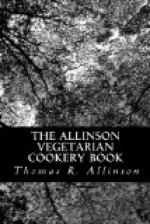EVE PUDDING.
1/2 lb. each of apples and breadcrumbs, and 1/2 lb. of currants and sultanas mixed, 5 eggs well beaten, sugar to taste, the grated rind and juice of 1 lemon, and 2 oz. of butter. Peel, core, and chop small the apples, mix them with the breadcrumbs, sugar, currants, and sultanas (washed and picked), the lemon juice and rind, and the butter, previously melted; whip up the eggs and mix them well with the other ingredients; turn the mixture into a buttered mould, tie with a cloth, and steam the pudding for 3 hours.
BREAD AND CAKES
THE ADVANTAGES OF WHOLEMEAL BREAD.
People are now concerning themselves about the foods they eat, and inquiring into their properties, composition, and suitability. One food that is now receiving a good deal of attention is bread, and we ought to be sure that this is of the best kind, for as a nation we eat daily a pound of it per head. We consume more of this article of food than of any other, and this is as it ought to be, for bread is the staff of life, and many of the other things we eat are garnishings. It is said we cannot live on bread alone, but this is untrue if the loaf is a proper one; at one time our prisoners were fed on it alone, and the peasantry of many countries live on very little else.
Not many years ago books treating of food and nutrition always gave milk as the standard food, and so it is for calves and babies. Nowadays we use a grain food as the standard, and of all grains wheat is the one which is nearest perfection, or which supplies to the body those elements that it requires, and in best proportions. A perfect food must contain carbonaceous, nitrogenous, and mineral matter in definite quantities; there must be from four to six parts of carbonaceous or heat and force-forming matter to one of nitrogen, and from two to four per cent. of mineral matter; also a certain bulk of innutritious matter for exciting secretion, for separating the particles of food so that the various gastric and intestinal juices may penetrate and dissolve out all the nutriment, and for carrying off the excess of the biliary and other intestinal secretions with the faeces.
A grain of wheat consists of an outer hard covering or skin, a layer of nitrogenous matter directly under this, and an inner kernel of almost pure starch. The average composition of wheat is this:—
Nitrogen 12
Carbon 72
Mineral Matter 4
Water 12
—–
100




